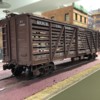Dear Members!
I am currently trying my luck on two of Ted Schnepf's fabulous stock car kits. This is (again) the first time to work with that material and I would like to address some questions here.
1) How do you get your parts straight? I read about boiling in hot water and indeed that softened the castings up. Once they cooled on the super flat kitchen worktop they had a tendency to regain the original warp. I used weights while cooling - resin was not impressed.
I read in the Andrews Trucks topic (Thanks to OSCALETRAINS!) that it takes a long time to "weight the parts straight". I do so but so far I can not see any progress. The curve in the parts is not really a problem when using some supporting angles and jigs for mounting. I decided to glue the parts together and it worked out just fine.

This poor woman's jig helped to glue the floor in the right position. Does the material really straight out when weighted just long enough? Thanks for your help! :-)
Sarah
S















